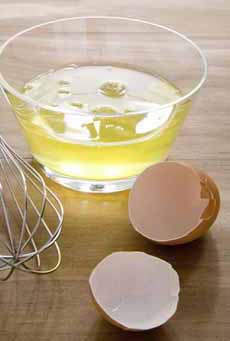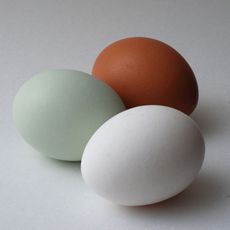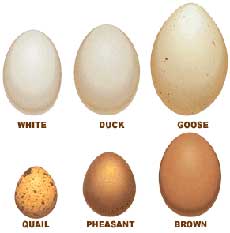

These eggs were gathered from different heritage breeds of chickens. These are the natural colors of the shells: The eggs are not dyed, and no color enhancements have been made to this photo. Photo by Hudson Bedell | IST.
January 2008
Last Updated March 2018
|
 |
The Different Types Of Eggs
A Glossary Of Egg Types, Terms & Definitions
Page 1: Terms From A To D
CAPSULE REPORT: The eggs of birds and reptiles (think turtle eggs) have been gathered for food since the dawn of man—and enjoyed by other animals since, well, the dawn of eggs. The most commonly-raised are chicken eggs; duck, goose, ostrich and quail eggs are used as gourmet ingredients; pheasant eggs and emu eggs can sometimes be found. But the ubiquitous chicken egg holds center stage in our egg glossary. This is Page 1 of a four-page article about chicken eggs. Click on the black links below to visit other pages.
Eggs are an inexpensive source of protein, a versatile ingredient and an essential component of foods we hold dear, from omelets to cakes and cookies. Just a few years ago, you had a choice of white or brown eggs. (White eggs come from white hen varieties, brown eggs come from brown-feathered hens, and are a bit more expensive because brown hens tend to be larger and consume more feed.)
Today, there are 10 choices to be made in chicken eggs alone. In addition to the regular brown and white eggs of yore, here are eight additional choices—most of which are available in brown or white as well. We also briefly address the other types of eggs that can be found in specialty food stores, on restaurant menus, and the websites of breeders who make them available to consumers nationwide.
EGG GLOSSARY
If you’d like to suggest additional words, click here. Beyond eggs, We have a food glossary for almost every specialty—visit the entire collection.
ALBUMEN
The albumen is the clear portion of the egg, the “egg white.” It comprises about two thirds of the egg mass and contains more than half of the protein and riboflavin. Two thick, twisted strands called the chalazae cords within the albumen anchor the yolk in place. Many people think they are imperfections, embryos or annoyances; but the more prominent the chalazae, the fresher the egg. They neither interfere with whipping the egg whites nor with cooking in general. The egg white will coagulate, becoming firm and opaque, at between 144ºF and 149ºF. See our article on making the perfect hard-boiled egg. See also yolk. |
|

Albumen, or egg white. Photo courtesy Pritikin.com. |
ANTIBIOTIC-FREE EGGS
Eggs contain no antibiotic residue, even if the hen has been given antibiotics. However, if she has had antibiotics, the eggs cannot be labeled anti-biotic free, even though they contain no antibiotics.
Egg laying hens are not given hormones, so all eggs are hormone-free.
ARACAUNA EGGS
Aracauna eggs are from Aracauna chickens, native to South America. Nutritionally, these bluish-green eggs are not much different fro traditional white and brown eggs. Although some people think aracauna eggs are lower in cholesterol, eggs from this breed have a higher cholesterol content.
While eggs in the U.S. come from cost-effective breeds that yield white or brown eggs, some non-commercial breeders have heritage breeds that yield beautiful colors, like the aracauna. For example, Penedesencas from Spain lay eggs that are a very dark, reddish brown.” Cuckoo Marans and Welsummers lay speckled eggs. Some Eggers lay pale green and olive. All in all, there’s a rainbow of options. |
|

The pale blue-green Aracauna egg, along with traditional white and brown varieties. Photo by Gmoose1 |Wikimedia. |
CAGE-FREE EGGS
Cage-free and free-range chicken eggs appeal to people who object to caging animals; however, the cage-free system does not necessary provide optimal safety to the hens. The “free” hens can be very crowded on a henhouse floor, and injury can result. Instead, better standards may come from a United Egg Producers Certified Egg.
Cage free is also known as free roaming. |
|

Cage free is not necessarily a good thing. Photo courtesy Fox News. |
CERTIFIED HUMANE
Certified by Humane Farm Animal Care (HFAC), the leading non-profit certification organization dedicated to improving the lives of farm animals in food production from birth through slaughter.
CERTIFIED ORGANIC
Subject to review and certification by the U.S.D.A. Hens must live in a cage-free environment, but not necessarily free range, i.e., roaming around a yard. They must be fed organic feed.
CHALAZAE CORDS
See albumen.
COMMERCIAL EGGS
A term for factory-farmed eggs, which inhumanely confine the hens to small cages where they can’t move. Unless the eggs are labeled cage free, certified humane, free range or pasture raised, this is how the hens spends their lives.
Photos:
[1] Certified Humane logo.
[2] Pasture-raised eggs from Vital Farms.
[3] Most of the hens in the world are confined to tiny cages (photo from Kienyeji.org).
|
|



Above: The reason to buy Certified Humane or Pasture Raised eggs. |

|









